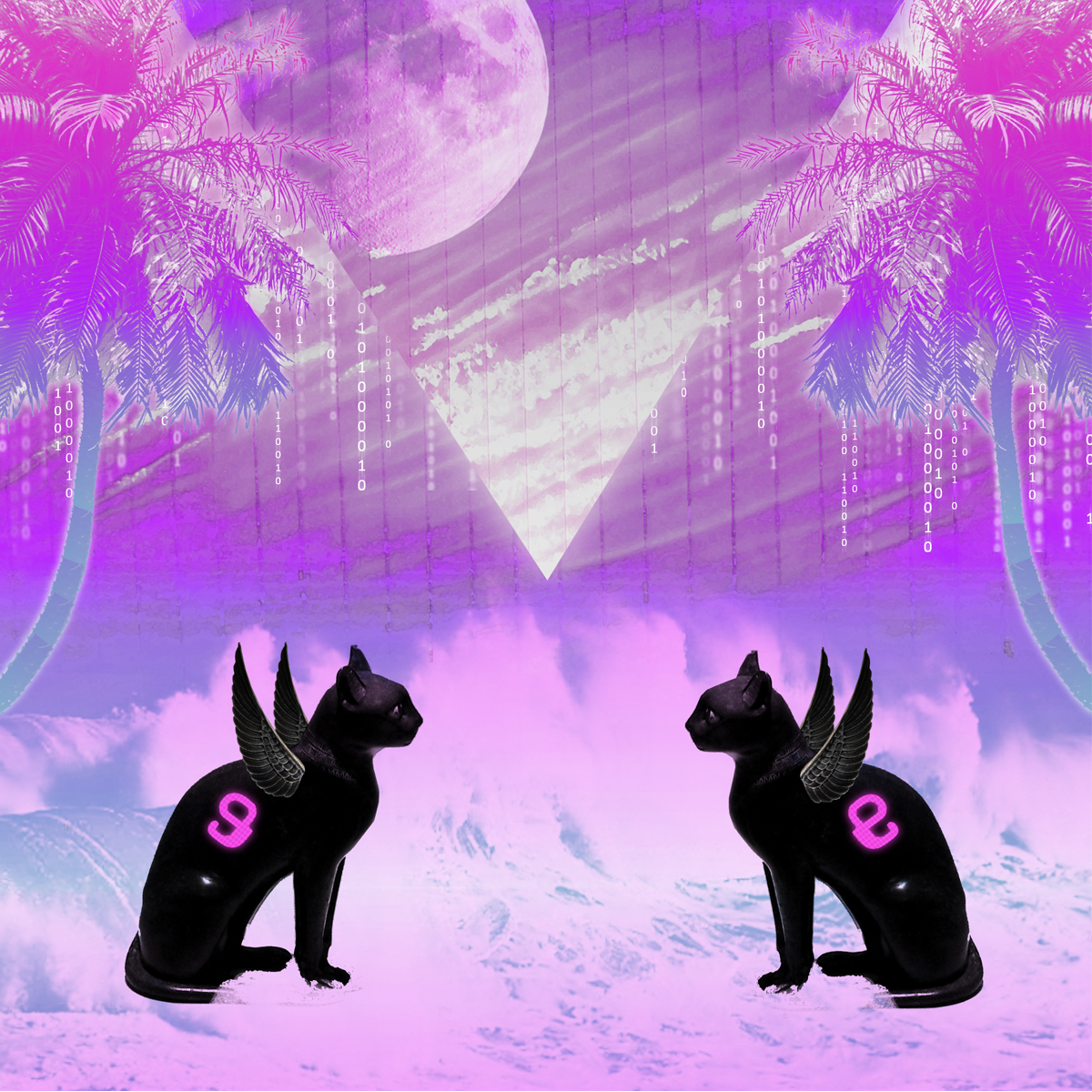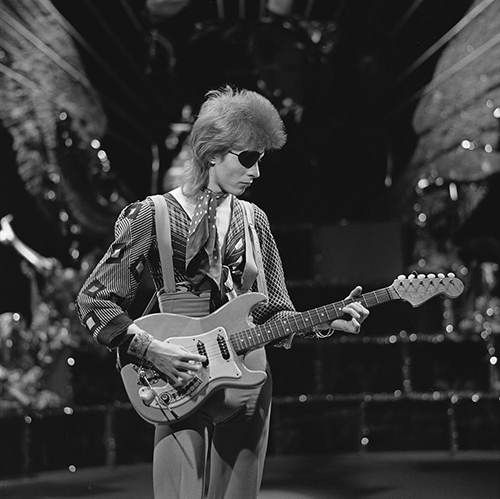|
Vaporwave
Vaporwave is a microgenre of electronic music, a visual art style, and an Internet meme that emerged in the early 2010s and became well-known in 2015. It is defined partly by its slowed-down, chopped and screwed samples of smooth jazz, 1970s elevator music, contemporary R&B, R&B, and lounge music from the 1980s and 1990s; similar to synthwave. The surrounding subculture is sometimes associated with an ambiguous or satirical take on consumer capitalism and pop culture, and tends to be characterized by a nostalgic or surrealist engagement with the popular entertainment, technology and advertising of previous decades. Visually, it incorporates early Internet imagery, late 1990s web design, glitch art, anime, stylized Ancient Greek sculpture, Ancient Greek or Roman sculptures, 3D rendering, 3D-rendered objects, and cyberpunk tropes in its cover artwork and music videos. Vaporwave originated as an ironic variant of chillwave, evolving from hypnagogic pop as well as similar retro- ... [...More Info...] [...Related Items...] OR: [Wikipedia] [Google] [Baidu] |
Hypnagogic Pop
Hypnagogic pop (abbreviated as h-pop) is pop music, pop or psychedelic music that evokes cultural memory and 1980s nostalgia, nostalgia for the popular entertainment of the past (principally the 1980s). It emerged in the mid to late 2000s as American lo-fi music, lo-fi and noise music, noise musicians began adopting retro aesthetics remembered from their childhood, such as mainstream rock, radio rock, new wave music, new wave pop, synth-pop, video game music, soft rock, light rock, and contemporary R&B, R&B. Recordings circulated on audio cassette, cassette or Internet blogs and were typically marked by the use of outmoded analog recording, analog equipment and do it yourself, DIY experimentation. The genre's name was coined by journalist David Keenan in an August 2009 issue of ''The Wire (magazine), The Wire'' to label the developing trend, which he characterized as "pop music refracted through the memory of a memory." It was used interchangeably with "chillwave" or "glo-fi" a ... [...More Info...] [...Related Items...] OR: [Wikipedia] [Google] [Baidu] |
Chillwave
Chillwave (originally considered synonymous with glo-fi and hypnagogic pop) is a music microgenre that emerged in the late 2000s. It is characterized by evoking the popular music of the late 1970s and early 1980s while engaging with notions of memory and nostalgia. Common features include a faded or dreamy retro pop music, pop sound, Escapism, escapist lyrics (frequent topics include the beach or summer), psychedelic music, psychedelic or lo-fi music, lo-fi aesthetics, mellow vocals, slow-to-moderate tempos, Effects unit, effects processing (especially reverb), and vintage synthesizers. Chillwave was one of the first music genres to develop primarily through the Internet. The term was coined in 2009 by the satirical blog Hipster Runoff to lampoon microgenres and indie acts whose sounds resembled incidental music from 1980s VHS tapes. Prior to this, the music would have been labelled as shoegaze, dream pop, ambient music, ambient, or indietronica. Leading acts included Neon Indi ... [...More Info...] [...Related Items...] OR: [Wikipedia] [Google] [Baidu] |
City Pop
is a loosely defined form of Japanese pop music that emerged in the late 1970s and peaked in popularity during the 1980s. It was originally termed as an offshoot of Japan's Western-influenced " new music", but came to include a wide range of styles – including funk, disco, R&B, AOR, soft rock, and boogie – that were associated with the country's nascent economic boom and leisure class. It was also identified with (at the time) new technologies such as the Walkman, cars with built-in cassette decks and FM stereos, and various electronic musical instruments. There is no unified consensus among scholars regarding the definition of city pop. In Japan, the tag simply referred to music that projected an " urban" feel and whose target demographic was urbanites. Many of the artists did not embrace the Japanese influences of their predecessors, and instead, largely drew from American funk, soft rock and boogie. Some examples may also feature tropical flourishes or elements taken ... [...More Info...] [...Related Items...] OR: [Wikipedia] [Google] [Baidu] |
Post-Internet
Post-Internet is a 21st-century art movement involving works that are derived from the Internet or its effects on aesthetics, culture and society. Definition Post-Internet is a loosely-defined term that was coined by artist/curator Marisa Olson in an attempt to describe her practice. It emerged from mid-2000s discussions about Internet art by Gene McHugh (author of a blog titled "Post-Internet"), and Artie Vierkant (artist, and creator of ''Image Object'' sculpture series). The movement itself grew out of Internet Art (or Net Art). According to the UCCA Center for Contemporary Art in Beijing, rather than referring "to a time “after” the internet", the term refers to "an internet state of mind". Eva Folks of AQNB wrote that it "references one so deeply embedded in and propelled by the internet that the notion of a world or culture without or outside it becomes increasingly unimaginable, impossible." The term is controversial and the subject of much criticism in the art com ... [...More Info...] [...Related Items...] OR: [Wikipedia] [Google] [Baidu] |
Vaporware
In the computer industry, vaporware (or vapourware) is a product, typically computer Computer hardware, hardware or software, that is announced to the general public but is late, never actually manufactured, or officially canceled. Use of the word has broadened to include products such as automobiles. Vaporware is often announced months or years before its purported release, with few details about its development being released. Developers have been accused of intentionally promoting vaporware to keep customers from switching to competing products that offer more features. ''Network World'' magazine called vaporware an "epidemic" in 1989 and blamed the press for not investigating if developers' claims were true. Seven major companies issued a report in 1990 saying that they felt vaporware had hurt the industry's credibility. The United States accused several companies of announcing vaporware early enough to violate Competition law, antitrust laws, but few have been found guilty. ... [...More Info...] [...Related Items...] OR: [Wikipedia] [Google] [Baidu] |
Art Pop
Art pop (also typeset art-pop or artpop) is a loosely defined style of pop music influenced by art theory, art theories as well as ideas from other art mediums, such as fashion, fine art, film, cinema, and avant-garde literature. The genre draws on pop art's integration of high culture, high and low culture, and emphasizes signs, style, and gesture over personal expression. Art pop musicians may deviate from traditional pop audiences and rock music conventions, instead exploring postmodern approaches and ideas such as pop's status as commercial art, notions of artifice and the self, and questions of historical authenticity. Starting in the mid-1960s, British and American pop musicians such as Brian Wilson, Phil Spector, and the Beatles began incorporating the ideas of the pop art movement into their recordings. English art pop musicians drew from their art school studies, while in America the style drew on the influence of pop artist Andy Warhol and the affiliated band the Velv ... [...More Info...] [...Related Items...] OR: [Wikipedia] [Google] [Baidu] |
Disruptive Editing
Disruption, disruptive, or disrupted may refer to: Business *Creative disruption, disruption concept in a creative context, introduced in 1992 by TBWA's chairman Jean-Marie Dru *Disruptive innovation, Clayton Christensen's theory of industry disruption by new technology or products Psychology and sociology *Disruptive behavior disorders, a class of mental health disorders *Disruptive physician, a physician whose obnoxious behaviour upsets patients or other staff *Social disruption, a radical alteration, transformation, dysfunction or breakdown of social life Arts and Entertainment *''The Disruption'', a 1996 EP by Cursive discography#EPs, Cursive *The Disruption (Succession), "The Disruption" (''Succession''), TV episode Other uses *Cell disruption is a method or process in cell biology for releasing biological molecules from inside a cell *''Disrupted: My Misadventure in the Start Up Bubble'', a 2016 book by Daniel Lyons *Disruption (adoption) is also the term for the cancellat ... [...More Info...] [...Related Items...] OR: [Wikipedia] [Google] [Baidu] |
Vice (magazine)
''Vice'' (stylized in all caps) is a Canadian-American magazine focused on lifestyle, arts, culture, and news/politics. It was founded in 1994 in Montreal as an alternative punk magazine, and its founders later launched the youth media company Vice Media, which consists of divisions including the printed magazine as well as a website, broadcast news unit, a film production company, a record label, and a publishing imprint. As of February 2015, the magazine's editor-in-chief is Ellis Jones. On 15 May 2023, Vice Media formally filed for Chapter 11 bankruptcy, as part of a possible sale to a consortium of lenders including Fortress Investment Group, which will, alongside Soros Fund Management and Monroe Capital, invest $225 million as a credit bid for nearly all of its assets. In February 2024, CEO Bruce Dixon announced additional layoffs and that the website Vice.com will no longer publish content. The print magazine returned in September 2024. History The precursor to ''Vice ... [...More Info...] [...Related Items...] OR: [Wikipedia] [Google] [Baidu] |
New Wave Music
New wave is a music genre that encompasses pop music, pop-oriented styles from the 1970s through the 1980s. It is considered a lighter and more melodic "broadening of Punk subculture, punk culture". It was originally used as a catch-all for the various styles of music that emerged after punk rock. Later, critical consensus favored "new wave" as an umbrella term involving many contemporary popular music styles, including synth-pop, alternative dance and post-punk. The main new wave movement coincided with late 1970s punk and continued into the early 1980s. The common characteristics of new wave music include a humorous or quirky pop approach, angular guitar riffs, jerky rhythms, the use of electronics, and a distinctive visual style in fashion. In the early 1980s, virtually every new pop and rock act – and particularly those that employed synthesizers – were tagged as "new wave" in the United States. Although new wave shares punk's do-it-yourself philosophy, the musician ... [...More Info...] [...Related Items...] OR: [Wikipedia] [Google] [Baidu] |
Plunderphonics
Plunderphonics is a music genre in which tracks are constructed by sampling (music), sampling recognizable musical works. The term was Neologism, coined by composer John Oswald (composer), John Oswald in 1985 in his essay "Plunderphonics, or Audio Piracy as a Compositional Prerogative", and eventually explicitly defined in the liner notes of his ''Grayfolded'' album. Plunderphonics is a form of sound collage. Oswald has described it as a referential and self-conscious practice which interrogates notions of originality and identity (philosophy), identity. Although the concept of plunderphonics is broad, in practice there are many common themes used in what is normally called plunderphonic music. This includes heavy sampling (music), sampling of educational films of the 1950s, news reports, Radio programming, radio shows, or anything with trained vocal announcers. Oswald's contributions to this genre rarely used these materials, the exception being his Rapping, rap-like 1975 track ... [...More Info...] [...Related Items...] OR: [Wikipedia] [Google] [Baidu] |
Pop Ballads
A sentimental ballad is an emotional style of music that often deals with romantic and intimate relationships, and to a lesser extent, loneliness, death, war, drug abuse, politics and religion, usually in a poignant but solemn manner. Ballads are generally melodic enough to capture the listener's attention. Sentimental ballads are found in most music genres, such as pop, R&B, soul, country, folk, rock and electronic music. Usually slow in tempo, ballads tend to have a lush musical arrangement which emphasizes the song's melody and harmonies. Characteristically, ballads use acoustic instruments such as guitars, pianos, saxophones, and sometimes an orchestral set. Many modern mainstream ballads tend to feature synthesizers, drum machines and even, to some extent, a dance rhythm. Sentimental ballads had their origins in the early Tin Pan Alley music industry of the later 19th century. Initially known as "tear-jerkers" or "drawing-room ballads", they were generally s ... [...More Info...] [...Related Items...] OR: [Wikipedia] [Google] [Baidu] |
Smooth Jazz
Smooth jazz is commercially oriented crossover jazz music. Although often described as a "genre", it is a debatable and highly controversial subject in jazz music circles. As a radio format, however, smooth jazz radio became the successor to easy listening music on radio station programming from the mid-1970s through the early 1990s. History Smooth jazz may be thought of as commercially-oriented, crossover jazz which came to prominence in the 1980s, displacing the more venturesome jazz fusion from which it emerged. It avoids the improvisational "risk-taking" of jazz fusion, emphasizing melodic form, and much of the music was initially "a combination of jazz with easy-listening pop music and lightweight R&B." During the mid-1970s in the United States, it was known as "smooth radio"; the genre was not termed "smooth jazz" until the 1980s. The term itself seems to have been birthed directly out of radio marketing efforts. In an industry focus group in the late 1980s, one pa ... [...More Info...] [...Related Items...] OR: [Wikipedia] [Google] [Baidu] |







